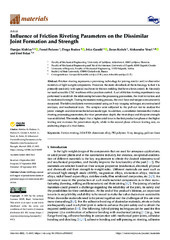Приказ основних података о документу
Influence of friction riveting parameters on the dissimilar joint formation and strength
| dc.creator | Klobčar, Damjan | |
| dc.creator | Pušavec, Franci | |
| dc.creator | Bračun, Drago | |
| dc.creator | Garašić, Ivica | |
| dc.creator | Kožuh, Zoran | |
| dc.creator | Vencl, Aleksandar | |
| dc.creator | Trdan, Uroš | |
| dc.date.accessioned | 2023-02-10T12:41:31Z | |
| dc.date.available | 2023-02-10T12:41:31Z | |
| dc.date.issued | 2022 | |
| dc.identifier.issn | 1996-1944 | |
| dc.identifier.uri | https://machinery.mas.bg.ac.rs/handle/123456789/4289 | |
| dc.description.abstract | Friction riveting represents a promising technology for joining similar and/or dissimilar materials of light-weight components. However, the main drawback of the technology is that it is primarily used only with special machines for friction welding that have a force control. In this study we used accessible CNC machines with a position control. A set of friction riveting experiments was performed to establish the relationship between the processing parameters, the rivet formation and its mechanical strength. During the manufacturing process, the axial force and torque were constantly measured. The fabricated joints were examined using an X-ray imaging technique, microstructural analyses, and mechanical tests. The samples were subjected to the pull-out test to analyse the joints’ strength and determine the failure mode type. In addition, a correlation between the friction riveting processing parameters, the rivet penetration depth, the rivet shape and the joint strength was established. The results depict that a higher axial force in the first production phase at the higher feeding rate increases the penetration depth, while in the second phase at lower feeding rate, an anchoring shape of a rivet forms. | sr |
| dc.language.iso | en | sr |
| dc.publisher | MDPI | sr |
| dc.relation | Slovenian Research Agency P2-0270 | sr |
| dc.relation | COST Action CA18120 | sr |
| dc.relation | Bilateral project between Republic of Serbia and Republic of Slovenia 337-00-00111/2020-09/50 and BI-RS/20-21-047 | sr |
| dc.relation | info:eu-repo/grantAgreement/MESTD/inst-2020/200105/RS// | sr |
| dc.rights | openAccess | sr |
| dc.rights.uri | https://creativecommons.org/licenses/by/4.0/ | |
| dc.source | Materials | sr |
| dc.subject | friction riveting | sr |
| dc.subject | 2024-T351 aluminium alloy | sr |
| dc.subject | PEI polymer | sr |
| dc.subject | X-ray imaging | sr |
| dc.subject | pull-out force | sr |
| dc.title | Influence of friction riveting parameters on the dissimilar joint formation and strength | sr |
| dc.type | article | sr |
| dc.rights.license | BY | sr |
| dc.citation.issue | 19 | |
| dc.citation.rank | M21 | |
| dc.citation.spage | 6812 | |
| dc.citation.volume | 15 | |
| dc.identifier.doi | https://doi.org/10.3390/ma15196812 | |
| dc.identifier.fulltext | http://machinery.mas.bg.ac.rs/bitstream/id/10146/materials-15-06812-v3.pdf | |
| dc.type.version | publishedVersion | sr |


